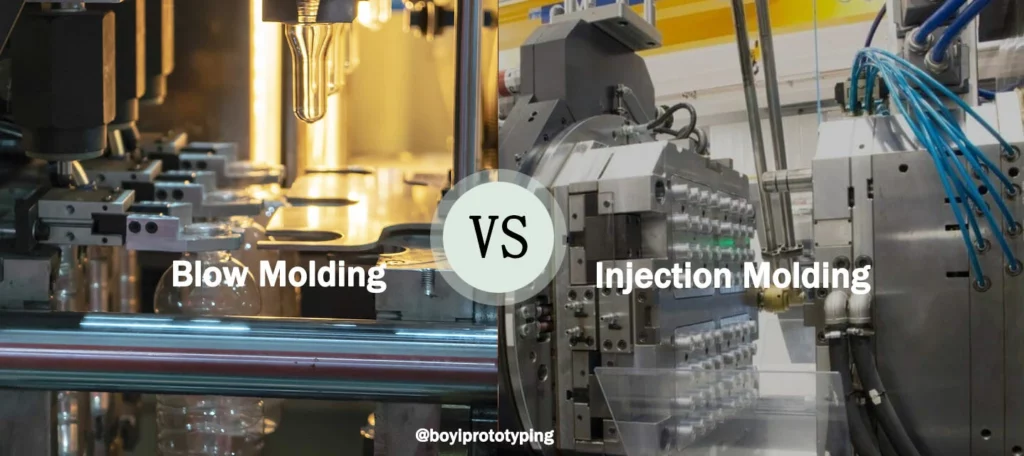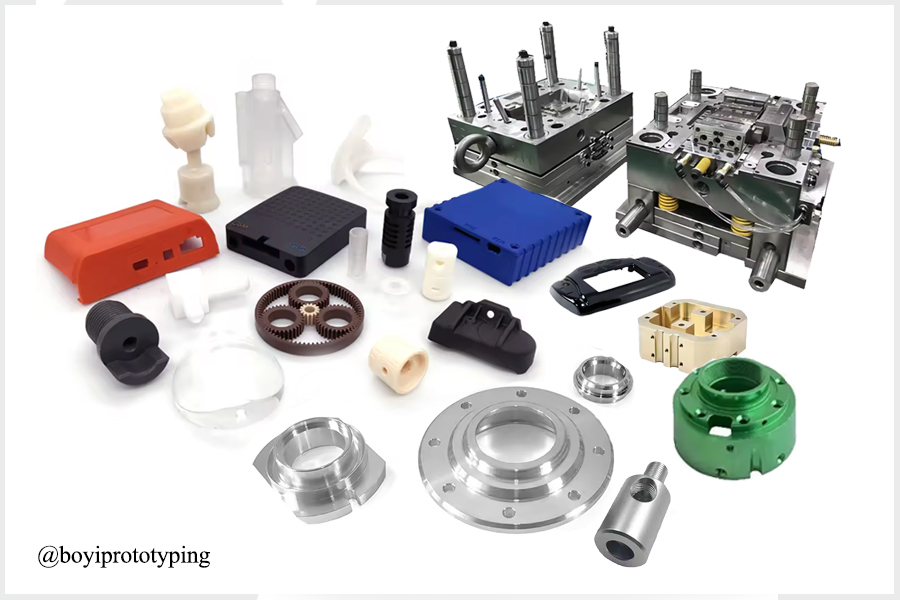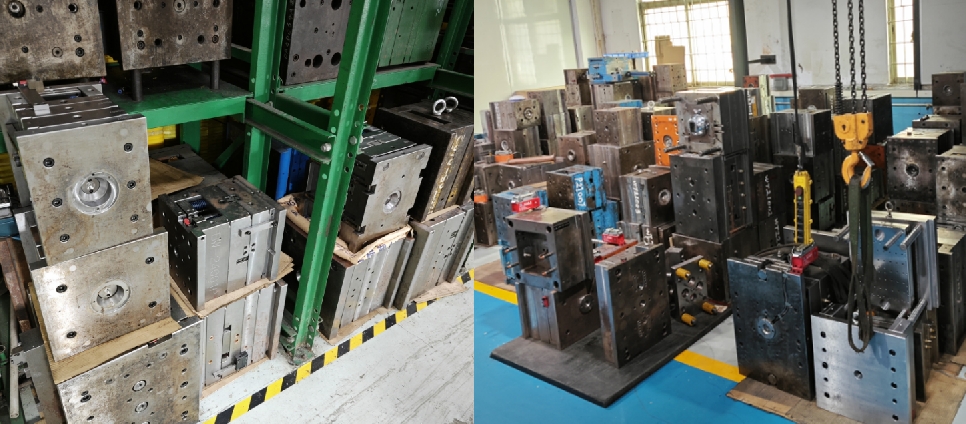
Blow molding and injection molding are two widely used manufacturing processes in the production of plastic parts. Each method offers distinct advantages and is chosen based on the specific requirements of the part being manufactured. Understanding the differences in cost and process can help in determining the most suitable method for a given application.
What is Blow Molding?
Blow molding is used primarily for producing hollow parts such as bottles, containers, and automotive ductwork. It involves melting plastic resin and forming it into a parison (hollow tube) which is then placed in a mold cavity. Compressed air is used to inflate the parison against the mold walls, shaping it into the final part form as it cools.
Key Features:
- Material Flexibility: Primarily used with thermoplastics but can accommodate a variety of materials.
- Production Speed: Slower than injection molding due to additional steps like parison formation and cooling.
- Tooling Costs: Generally lower tooling costs compared to injection molding.
- Part Complexity: Best suited for parts with uniform wall thickness and simple geometries.
- Post-Processing: May require trimming and finishing of excess material.

What are the Types of Blow Molding?
There are several types of blow molding processes, each suited to different manufacturing needs:
- Extrusion Blow Molding (EBM):
- Used primarily for manufacturing hollow parts with uniform wall thickness.
- A heated plastic tube (parison) is extruded and clamped in a mold.
- Compressed air inflates the parison to conform to the mold cavity.
- Commonly used for producing bottles, containers, and automotive ducts.
- Injection Blow Molding (IBM):
- Combines elements of injection molding and blow molding.
- A preform is injection molded, which is then transferred to a blow mold.
- Compressed air inflates the preform to the shape of the mold cavity.
- Ideal for producing complex shapes and high-precision parts like medical devices and pharmaceutical containers.
- Stretch Blow Molding (SBM):
- Involves stretching a preform before blowing it into the mold cavity.
- Achieves enhanced material properties and precise dimensional control.
- Commonly used for producing PET bottles and containers for beverages and personal care products.
These types of blow molding processes offer versatility in manufacturing various types of hollow plastic parts, catering to different industries and product applications.
How Does Blow Molding Work?
Blow molding is a manufacturing process used primarily for creating hollow plastic parts such as bottles, containers, and automotive ductwork. The process begins with plastic resin pellets being melted and extruded into a tubular shape known as a parison. This parison is then placed into a mold cavity, typically consisting of two halves that enclose the parison.
Once in the mold, compressed air is introduced either through a blow pin or directly into the parison. This pressurized air expands the plastic against the walls of the mold, shaping it to match the mold cavity’s contours. As the plastic cools and solidifies, it adopts the final shape of the part.
After cooling, the mold opens to release the formed part, which is then trimmed to remove any excess material, known as flash, typically found at the mold’s parting line. This excess material is recycled back into the manufacturing process to minimize waste. The finished parts may undergo additional finishing processes such as trimming, printing, or labeling before final inspection and packaging.
What Products Can Be Produced By Blow Molding?
Blow molding can produce:
- Bottles
- Containers
- Jerrycans
- Automotive ducts
- Fuel tanks
- Hollow toys
- Drums
- Plastic chairs
Advantages and Disadvantages of Blow Molding
Blow molding is a versatile manufacturing process with distinct advantages and disadvantages:
Advantages
- Cost-effective for Large Production Runs: Once the mold is set up, blow molding can produce parts at a relatively low cost per unit, especially for high-volume production.
- Complex Shapes and Uniform Wall Thickness: It allows for the production of hollow parts with intricate shapes and consistent wall thickness, making it suitable for a wide range of products like bottles and containers.
- Material Efficiency: Blow molding typically generates less material waste compared to other processes like injection molding, as excess plastic (flash) can often be recycled.
- Fast Production Cycles: The process of forming and cooling parts can be efficient, especially with modern automated systems, enabling quick turnaround times for large orders.
- Variety of Materials: It can accommodate various thermoplastics and even some thermosetting materials, providing flexibility in material selection for different application needs.
Disadvantages
- Limited Part Design Flexibility: Compared to injection molding, blow molding is less suitable for highly complex parts with intricate details or varied wall thicknesses.
- Mold Design Complexity: While simpler than injection mold, blow mold designs can still be costly and time-consuming to create, particularly for unique or custom shapes.
- Quality Control Challenges: Ensuring uniform wall thickness and preventing defects like thin spots or uneven distribution of material can be challenging, impacting overall part quality.
- Size Limitations: Large or very small parts may be difficult to produce with blow molding, as it is optimized for mid-range part sizes typically used in packaging and container applications.
- Secondary Operations Required: Depending on the application, additional trimming, finishing, or assembly steps may be necessary to achieve the desired final product specifications.
Blow molding is valued for its efficiency in producing hollow plastic parts with consistent properties, making it a preferred choice for industries requiring high-volume production of containers and similar products.
What is Injection Molding?
Injection molding involves injecting molten plastic material into a mold cavity under high pressure. The plastic material is heated to a molten state and then injected into the mold where it cools and solidifies to form the desired part shape. This process is highly automated and suitable for high-volume production.
Key Features:
- Material Flexibility: Supports a wide range of materials including thermoplastics, thermosets, and elastomers.
- Precision: Offers high precision and intricate detail, making it ideal for complex part geometries.
- Production Speed: Fast cycle times enable efficient mass production.
- Tooling Costs: Initial tooling costs can be high due to the complexity and precision required for molds.
- Part Complexity: Well-suited for parts with intricate features and tight tolerances.
- Post-Processing: Minimal post-processing required as parts typically come out of the mold with finished surfaces.

How Does Injection Molding Work?
Injection molding is a highly efficient process used for manufacturing plastic parts in large quantities. It begins with the preparation of plastic resin pellets, which are melted in a heated barrel of an injection molding machine. Once melted to the desired consistency, the molten plastic is injected into a carefully designed mold cavity under high pressure.
The mold itself is typically made of two halves: a stationary half and a movable half. These halves are precision-machined to create the specific shape and features required for the part being produced. When the molten plastic is injected into the mold cavity, it rapidly cools and solidifies, taking on the shape of the mold.
After the plastic has solidified, the mold opens, and the newly formed part is ejected using ejector pins. This process ensures that each part is produced with consistent quality and precise dimensions. Depending on the design and requirements of the final part, additional finishing processes such as trimming excess material, assembly, or surface finishing may be performed.
What Products Can Be Produced By Injection Molding?
Products that can be produced by injection molding include:
- Caps and closures
- Medical devices
- Automotive components
- Electronic housings
- Consumer goods (e.g., kitchenware, toys)
- Packaging components
- Thin-walled parts
- Industrial parts
Advantages and Disadvantages of Injection Molding
Injection molding offers several advantages and disadvantages, making it a versatile but specific manufacturing choice:
Advantages
- High Precision and Complexity: Injection molding enables the production of highly intricate and complex parts with precise dimensions and detailed features.
- Efficiency in High Volumes: Once the mold is set up, the injection molding process can produce large quantities of parts with consistent quality and minimal variation.
- Wide Range of Materials: It supports a broad selection of materials, including thermoplastics, elastomers, and thermosets, offering flexibility to meet diverse application requirements.
- Minimal Material Waste: Injection molding generates minimal scrap material as excess plastic (runners and sprues) can often be recycled back into the process.
- Automation and Cost Efficiency: Automation is common in injection molding, reducing labor costs and improving production efficiency for mass production.
Disadvantages
- High Initial Tooling Cost: The cost of designing and manufacturing molds for injection molding can be significant, especially for complex or custom parts.
- Lead Time for Tooling: Creating molds can take time, potentially delaying initial production runs and impacting time-to-market for new products.
- Part Design Constraints: Parts designed for injection molding must consider moldability, which may limit design flexibility compared to other manufacturing processes.
- Material Selection Limitations: While versatile, not all materials are suitable for injection molding, and specific material properties may influence part design and performance.
- Environmental Considerations: The energy-intensive nature of heating and cooling processes in injection molding can have environmental implications if not managed efficiently.
Injection molding excels in producing high-quality parts with complex geometries and tight tolerances, making it ideal for industries such as automotive, electronics, medical devices, and consumer goods.
Comparison Table Between Blow Molding vs Blow Molding
Here’s a comparison table between blow molding and injection molding based on their attributes:
| Attribute | Blow Molding | Injection Molding |
|---|---|---|
| Process | Blow molding creates hollow parts by inflating molten plastic into a mold cavity. It is ideal for producing containers, bottles, and automotive ducts. | Injection molding injects molten plastic into a mold cavity under high pressure. It excels in producing intricate, high-precision parts for various industries. |
| Mold Design | Molds have more flexibility but can lead to issues like air leaks and wall thinning. | Requires highly precise molds for complex designs, often made using CNC machining for accuracy and durability. |
| Typical Tooling Cost per Part | $1,000 to $100,000. Blow molding molds are simpler and less expensive compared to injection molds, suitable for medium to large production runs. | $10,000 to $1,000,000. Injection molds are complex and precise, necessitating higher initial investment but enabling high-volume production with minimal variation. |
| Post-Processing Needed | Minimal. Blow molded parts often require trimming of excess material (flash) but generally have finished surfaces, reducing post-processing needs. | Injection molded parts typically require trimming of runners and sprues, along with additional finishing operations such as painting, printing, or assembly. |
| Precision Parts for Engineering Applications | Blow molding is limited to producing simpler shapes and does not offer the precision required for engineering applications with tight tolerances. | Injection molding excels in producing highly detailed and complex parts, meeting stringent engineering specifications and dimensional accuracy requirements. |
| Materials and Color Options | Commonly uses soft and flexible plastics like HDPE, LDPE, and PP; limited to simple color options. | Compatible with a wide range of plastics including hard polymers like polycarbonate; offers extensive color options and material versatility. |
| Types of Parts | Produces hollow products such as bottles, containers, and fuel tanks. | Produces solid parts with rigid walls like caps, electronic housings, and medical devices. |
Additional Comparison
- Cost Efficiency: Blow molding is generally more cost-effective for large production runs due to lower tooling costs and simpler mold designs. Injection molding, despite higher initial costs, offers economies of scale for mass production of intricate parts.
- Speed and Volume: Injection molding processes parts faster with shorter cycle times once molds are set up, making it suitable for high-volume production environments. Blow molding, while efficient, may have longer cycle times depending on part complexity and cooling requirements.
- Application Diversity: Both processes serve distinct purposes in industrial manufacturing. Blow molding is ideal for producing lightweight, hollow products like bottles and containers, whereas injection molding is preferred for engineering applications requiring precise dimensions, complex geometries, and superior part quality.
This comprehensive comparison highlights the strengths and applications of blow molding and injection molding, helping manufacturers choose the most suitable process based on their specific production requirements and budget considerations.
Which is Better: Injection Molding or Blow Molding?
The choice between injection molding and blow molding depends on specific manufacturing requirements:
- Injection Molding is typically better for:
- Producing intricate parts with complex geometries and precise dimensions.
- High-volume production where efficiency and repeatability are critical.
- Using a wide range of materials including thermoplastics, thermosets, and composites.
- Blow Molding is often preferred for:
- Creating hollow, thin-walled parts like bottles, containers, and automotive ducts.
- Cost-effective production of large quantities of uniform parts.
- Applications where lightweight and durable hollow structures are needed.
Ultimately, the “better” method depends on factors such as part design complexity, production volume, material requirements, and budget constraints. Each method has its strengths and is chosen based on specific project needs in industrial manufacturing.
Alternative Solutions for Blow Molding and Injection Molding
When considering alternatives to injection molding and blow molding, two notable methods that offer unique capabilities are vacuum forming and 3D printing:
Vacuum Forming
Vacuum forming is a manufacturing process used to create thin-walled plastic parts by heating a plastic sheet until it becomes pliable and then stretching it over a mold.
- Process Overview: Vacuum forming involves heating a plastic sheet, typically made of thermoplastics like ABS or polycarbonate, until it softens. The heated sheet is then draped over a mold and vacuum pressure is applied to draw the sheet tightly against the mold’s contours. This process forms the desired shape as the plastic cools and solidifies.
- Applications: Vacuum forming is suitable for producing large, shallow parts with uniform wall thickness, such as packaging trays, automotive interior components, and disposable containers.
3D Printing
3D printing, also known as additive manufacturing, builds three-dimensional objects layer by layer from digital models.
- Process Overview: 3D printing uses various technologies to deposit materials (plastics, metals, ceramics) layer by layer, based on a digital CAD model. It offers flexibility in part design and can produce highly complex geometries without the need for traditional tooling or molds. While primarily used for prototyping and low-volume production, advancements in technology are expanding its application into end-use parts.
- Applications: 3D printing is ideal for rapid prototyping, custom tooling, and low-volume production of intricate parts across industries such as aerospace, automotive, healthcare, and consumer goods.
Comparison and Suitability
- Production Volume: Vacuum forming and 3D printing are suited for low to medium production volumes compared to injection molding and blow molding, which excel in high-volume production.
- Part Complexity: While both vacuum forming and 3D printing can handle complex geometries, 3D printing offers greater design freedom and customization due to its layer-by-layer additive process.
- Material Compatibility: Vacuum forming primarily uses thermoplastic sheets, while 3D printing offers a wider range of materials including plastics, metals, and composites, expanding its application possibilities.
Vacuum forming and 3D printing provide viable alternatives to injection molding and blow molding, each offering unique advantages in terms of design flexibility, cost-effectiveness for low-volume production, and suitability for producing complex parts. Choosing the right manufacturing method depends on specific project requirements such as production volume, part complexity, and material properties needed.
Get Your Custom Plastic Molded Parts
Looking for high-quality custom plastic molded parts? Discover BOYI’s expertise in precision manufacturing. Whether you need intricate components for automotive, medical, or consumer electronics industries, BOYI delivers precision and reliability. With state-of-the-art injection molding capabilities, we ensure your parts meet exact specifications for durability and performance.
Partner with BOYI for cost-effective solutions and exceptional service in custom plastic molding. Let’s bring your designs to life with precision and efficiency.

Let’s Start A New Project Today
Our engineers will contact you within 2 hours.
FAQ
Blow molding and injection molding, while distinct processes, share similarities in their utilization of thermoplastic materials for manufacturing plastic parts. Both methods involve heating plastic resins to a molten state for shaping into desired forms.
Injection molding, unlike blow molding, differs significantly from processes such as compression molding and extrusion molding. Compression molding involves compressing heated plastic into a mold cavity to form parts, suitable for complex and durable components. Extrusion molding forces molten plastic through a die to create continuous profiles or parts with consistent cross-sections like pipes and sheets.
Besides injection molding, blow molding can be compared with other manufacturing processes such as rotational molding and thermoforming. Buy comparatively, blow molding excels in producing lightweight, hollow parts with consistent wall thickness, making it ideal for applications such as bottles, containers, and automotive components.
Catalog: Injection Molding Guide

This article was written by engineers from the BOYI team. Fuquan Chen is a professional engineer and technical expert with 20 years of experience in rapid prototyping, mold manufacturing, and plastic injection molding.




